The AMD Trinity Review (A10-4600M): A New Hope
by Jarred Walton on May 15, 2012 12:00 AM ESTAMD Trinity: Battery Life Also Improved
With all of the changes going into Trinity, one thing that hasn’t changed since Llano is the process technology. Trinity is once again coming on a 32nm process from GlobalFoundries. If we were talking about Intel, Trinity would represent a “Tock” on the roadmap—a new architecture on an existing process. We’ve looked at CPU and GPU performance, and this is a part that’s pretty much universally faster than its predecessor. Given the lengthier pipeline and Bulldozer-derived architecture, I admit that I was concerned Trinity might actually be a step back for battery life; it appears that my fears were unfounded, largely due to the improvements in Piledriver. As usual, we tested with all laptops set to 100 nits brightness in our idle, Internet, and H.264 playback tests. I also ran some additional tests which we’ll discuss in a moment. First, here are the standard battery life results:
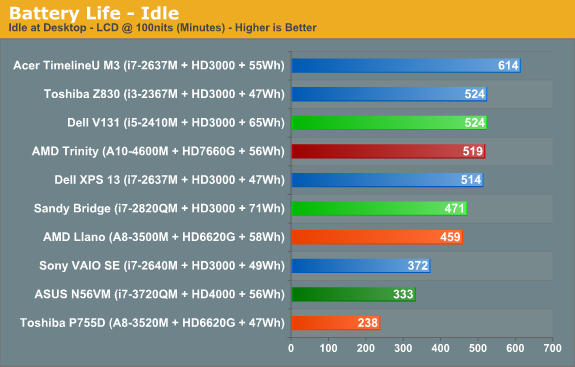
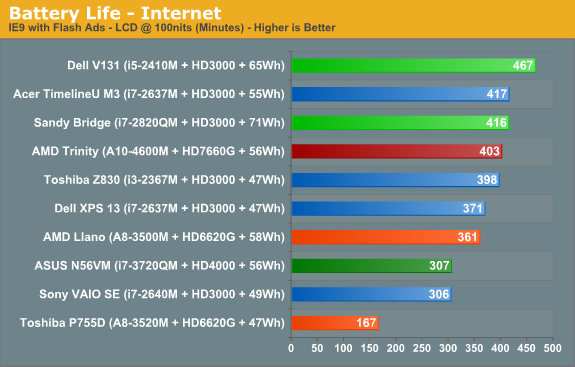
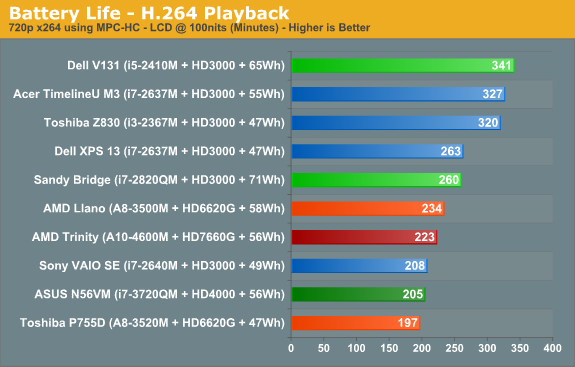
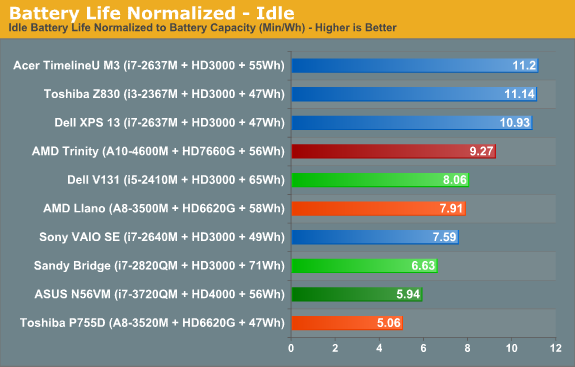

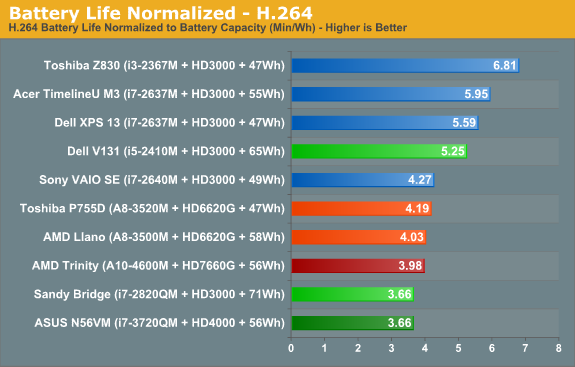
With a similar capacity battery to the original Llano laptop, and the same size 14” panel, Trinity comes out of the gates and posts two clear wins: idle battery life and Internet battery life are both up substantially relative to Llano. In fact, looking at the normalized charts, the only laptops that can consistently beat Trinity are found in Sandy Bridge ultrabooks—we won’t even bother discussing Atom or Brazos netbooks, as they’re competing in a completely different performance bracket. In something of a surprise, H.264 battery life doesn’t see the same benefit unfortunately, and it’s the one discipline where Llano still holds on to a slight lead over Trinity. Sandy Bridge meanwhile has always done very well in H.264 battery tests, and we see that with the Vostro V131 posting a normalized score that’s 30% better than Trinity and Llano. Of course, on the other end of the spectrum we have Ivy Bridge; we’ve only looked at one Ivy Bridge laptop so far, but if the pattern holds than Ivy Bridge will generally be a moderate step back in battery life relative to Sandy Bridge, giving AMD an even larger lead in this area.
We also performed a few other tests that we won’t present in graph form. One set of tests we alluded to earlier: the charts show Trinity with a Samsung 830 SSD, but we also ran tests with an Intel 520 SSD. Idle battery life dropped to 476 minutes (an 8% decrease), Internet battery life checked in at 371 minutes (down 8% again), and H.264 battery life stayed nearly the same at 217 minutes (down less than 3%). If battery life is one of your primary concerns, remember: all SSDs are not created equal!
Another test that we ran is simulated gaming; we looped the four graphics tests in 3DMark06 at 1366x768 until the battery ran out. We’ve run this same test on quite a few other laptops, and Llano initially looked to be far and away the best solution. Later, we discovered that when we tested Llano we were letting the GPU run in power saving mode—basically half the performance you’d get compared to being plugged in. We retested and measured 98 minutes, so the extra graphics performance comes with a heavy cost. We only tested Trinity (and Ivy Bridge and Sandy Bridge) using higher performance graphics settings, and this is one more area where it scores worse than Llano: Trinity managed just 77 minutes. That’s about the same as Ivy Bridge and Sandy Bridge (79 and 73 minutes, respectively), so if you’re after better gaming performance while running off the mains, you might need to keep looking.
Before getting too carried away with the above results, you still need to consider how important battery life is for your usage model. Some people travel a lot and like to go all day without plugging in; others will go from place to place and plug in whenever they’re not on the go. If you fall in the latter category, battery life isn’t usually a problem with any decent laptop, while those looking for all-day computing will definitely want as much mobility as possible. Ultimately, battery life is a factor of battery capacity as well as power optimizations done by the OEMs. We’ve seen battery life improve by as much as 50% when comparing two otherwise similar notebooks, but at least AMD’s reference platform for Trinity delivers a great starting point.
Temperatures and Acoustics
One other item we wanted to quickly touch on is system temperatures. We typically use HWMonitor and check temperatures of laptops under idle and load conditions. We did this with Trinity as well, but unfortunately the current version of HWMonitor doesn’t give us a lot of information. The only temperatures it reports are from the SSD and the HD 7660G graphics—there’s nothing about CPU core temperatures. That means we can’t provide much detail, other than to say that load temperature on the GPU topped out at 71C during extended testing, while the idle temperature was 39C. As usual, temperatures and noise levels go hand in hand, and the low 71C maximum GPU temperature matches up nicely with noise levels that never got above 37dB. It’s not the quietest laptop we’ve ever tested, and surface temperatures can get a little warm, but overall Trinity looks to be a good balance of performance and power requirements, which means quiet laptops are definitely possible.










271 Comments
View All Comments
bji - Tuesday, May 15, 2012 - link
What exactly about the review turned you off from Trinity for HTPC purposes?Was it the good-enough-for-HTPC CPU performance?
The superior GPU performance?
The better power efficiency?
The lower power use?
The cooler GPU?
The lower price (than the i3 you mentioned)?
Honestly just curious about why you so summarily concluded that Trinity wouldn't be a good choice from your HTPC when I can't see anything in the article that would allow you to draw that conclusion.
Unless it was the CPU chart comparison against at 3x as expensive CPU that you would never use in an HTPC anyway?
cjs150 - Wednesday, May 16, 2012 - link
The main purpose will be as an HTPC, video transcoding is very important, look back to Jarred's review, Intel are winning by a large margin.For the case I intend to use as long as TDP is under 50W there are no concerns.
For me the i7-3770T will be the way to go. But you may want to try AMD. If I had built the HTPC last year there would have been no question that AMD would have been the right choice - Atom is/was useless. Maybe next year the table will turn again.
Spunjji - Wednesday, May 16, 2012 - link
Soooo... AMD are good against Atom, so you would have bought them then... but now you're buying an i7 with which they (obviously) cannot compete? That particular argument is a little difficult to follow, unless your requirements have drastically altered. :)To be fair to AMD, most people I know don't do transcodes while at the machine so speed isn't terribly relevant past a certain point, but I understand this may be different for you.
DellaMirandola13 - Tuesday, May 15, 2012 - link
I have really been looking forward to this review, nice to see a reasonably competitive CPU-market. Thank you.I am not a (serious) enthusiast, my best suit is lurking, but I was very excited to learn about the heterogeneous aspect. Is it possible you could elaborate or perhaps link to a comprehensive elaboration on the prospects of heterogeneous computing.
As far as I could tell, it seemed very useful in navigating within GIS-applications (particularly when you have to load roads or other kinds of grids on a map), but that's pure speculation.
Jedibeeftrix - Tuesday, May 15, 2012 - link
I would be interested in a 14" hp sleekbook if it comes with the 25w 4655M APU, as the full 384 shaders would be nice, otherwise I will wait till 28nm APU's arrive in 2013 sporting GCN.Ps test trinity with blender cycles.
Veroxious - Tuesday, May 15, 2012 - link
I am rather baffled by the fact that Ivy Bridge did not bring substantial battery life improvements with it 22nm process. Is it as a result of the trigate transistor tech? By extension when AMD moves to 22nm will it also be trigate seeing that they no longer have their own foundry? Has trigate given the purported benefits that were punted when it was announced, or is it simply a case of the 22nm node not being mature enough?JKnows - Tuesday, May 15, 2012 - link
It would be nice to see those game test in High settings! My personal tests shows in high details settings Llano faster than HD4000, Trinity should be much faster.tipoo - Tuesday, May 15, 2012 - link
This is true. The HD4000 falls further and further behind as you increase the detail settings; that's where AMDs implementation shines.JarredWalton - Tuesday, May 15, 2012 - link
Go look at Mobile Bench: the results for our "High 900p" testing is in there.http://www.anandtech.com/bench/Product/600?vs=580
But just to summarize, at 900p "High" settings, Trinity's lead over HD 4000 grows to 26% in our seven "2012 Suite" games. Also worth note is that Trinity is >30 FPS in three titles (DiRT 3, Portal 2, and Total War: Shogun 2) while Ivy Bridge is >30 FPS only in DiRT 3 (but comes very close in Skyrim).
Alexko - Tuesday, May 15, 2012 - link
"I’d say AMD GPUs as well, but I’m still waiting for a better switchable graphics solution."You mean like Enduro?